Castles
Somehow I became interested in medieval castles. I am certainly not clear how this happened but they certainly now hold a fascination for me. Like so many things I think it may be my mother's fault, for taking me to the Keep at Newcastle. When I have the time I have a tendency to wander off to visit some nearby castle. I've even roped Rachel into this. She doesn't seem to mind too much. At least it gets us out, often to what people who like such things describe as nice villages. Also often to quite obscure places along roads only just on the map. Find out about some of the castles I've visited below. As with everything (as best I can tell anyway) the internet offers many resources.
Some Visited Castles
Each entry has brief details and gives an OS map reference (linked here to multimap.com because it understands them. Individually castle pages also link to Google (best maps) and Live Local (best aerial views)). Each castle also has it's own page, with any further details and thoughts, and more photographs (note that's only partially true as yet. It will be completely true when I find the time to finish it).
Richmond Castle
Richmond, North Yorkshire NZ 171 007
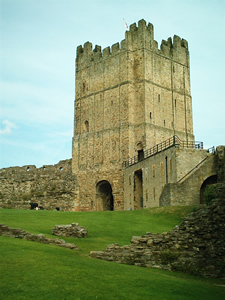
A magnificent eleventh century castle with a dramatic location. Richmond castle stands on a triangular rocky outcrop high above the River Swale, offering natural protection augmented by the high curtain wall built around two sides of the outcrop (a third length of wall was later added, but initially the sheer cliff down to the river was thought more than adequate). The imposing keep is actually a 12C addition, built over and in front of the original entrance archway which now leads into the keep's basement. Richmond Castle contains possibly the oldest hall in England, the magnificent Scollard's Hall, now a roofless shell, overlooking the steep cliff down to the Swale. Richmond also boasts the oldest flanking towers of an English medieval castle (including the curiously named Robin Hood Tower and Gold Hole Tower). Well worth a visit.
Bolton Castle
Near Leyburn, North Yorkshire SE 034 918
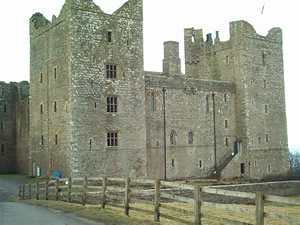
Bolton Castle is one of my favourite castles. It's near, so I've been there a few times. Strangely I doubt that I would have thought this would be one of my favourites. It's a fourteenth century quadrangular castle, built by Richard, Lord Scrope (licence to crenellate 1379 though it was nearly finished by then). Although ruined it is quite well preserved, and certainly one of the best preserved of it's type. Four ranges of rooms surround the central courtyard, and towers rise from each of the four corners (though they don't project enough to be flanking towers in the strict sense). The western range is still practically habitable, the guest hall now forming a tea room! The main gateway led into the central courtyard, from where five portcullised doorways lead off, each identical so as to give no clue of importance. It is likely the eastern range, by the gateway, could form a place of retreat if need be. Almost inevitably Mary Queen of Scots had a stay in this castle. Bolton was slighted by the parliamentary forces during the civil war (following a year long siege).
Helmsley Castle
Helmsley, North Yorkshire SE 611 836
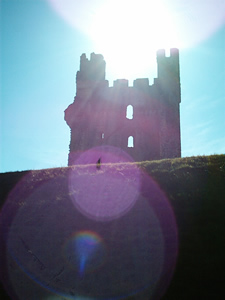
The first castle at Helmsley was a rectangular ringwork affair, with wooden buildings, built by Walter l'Espec sometime in the early twelfth century. The stone castle (and indeed most of what is seen now) is attributed to Robert de Roos in the late twelfth, early thirteenth century. There is a curtain wall with round corner towers. Entrance is by a strong northern gateway and smaller southern entrance (a large barbican was later added to this, as was an outer gatehouse to the northern gate). Unusually there is no keep as such, but two large towers in the western and eastern curtain walls. The larger eastern tower probably served the purpose of keep. A Tudor mansion now stands within the shell of the west tower and the twelfth century hall. The castle was severely slighted after falling to Sir Thomas Fairfax during the civil war.
Middleham Castle
Middleham, North Yorkshire SE 128 876
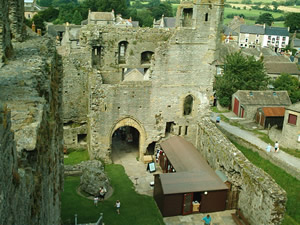
The current Middleham castle was built in 1170 or thereabouts by Ribald Fitz Ranulf, there having previously been an earthwork on William's Hill a little to the south west. The castle was dominated by a keep over 100 foot long, divided length ways by a cross-wall. The castle was enlarged in about 1300 by Ralph Neville, building a curtain wall close round the keep. In the 1400 new lodgings were built against the curtain wall on three sides, and the wall itself was heightened. The future King Richard III spent much time at Middleham as a young man and it became his principle northern castle.
Skipton Castle
Skipton, North Yorkshire SD 995 519
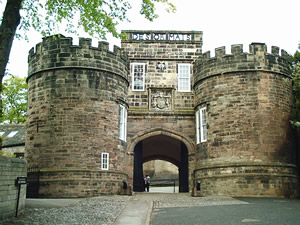
Although Skipton castle was founded by Rober de Ronille circa 1090 what is seen is due to the Clifford family, beginning with Robert de Clifford in 1310. Physically the castle sits atop a cliff above the Eller Beck. There was an outer bailey, the round tower flanked gatehouse of which still stands. Most of the outer bailey defences are lost, though one tower remains at the end of the Tudor mansion which adjoins the inner curtain. The inner curtain is essentially D-shaped, forming what is almost a shell keep it is of such small circumference. The flattened part of the D follows the cliff edge whilst the curved part is protected by impressive round towers. Two of these flank the main entrance, though the front of this is obscured by a Tudor porch. The centre of this D forms the "conduit court", surrounded by domestic buildings. The court is now dominated by the yew tree planted by Lady Ann Clifford when she restored the castle after the seemingly inevitable civil war slighting (though Skipton suffered little from this).
Castle Acre Castle
Castle Acre, Norfolk TF 820 152
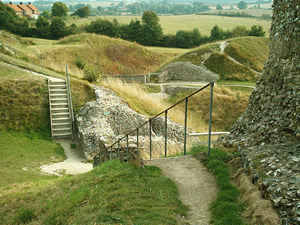
Although at first it may appear to be a series of hillocks in a field, with little in the of masonary ruins, one still gets a real, almost enchanting sense of Castle Acre's layout. Walking through the earthworks it emerges before you, until one finds oneself standing in the bailey looking around at the protecting banks ringing it. Castle Acre began as a fortified hall with a surrounding ringwork, owned by William de Warenne. Around 1140 the 3rd William de Warenne transformed the hall into a strong keep, converting the ringwork into a motte in the process. However only half the hall was converted, leaving a rather rectangular structure rather than the intended divided square tower, as still evidenced by the ruinous remains. Parts of the curtain wall still remain atop the bank and the base of the gatehouse is visible.
Castle Rising Castle
Castle Rising, Norfolk TF 666 246
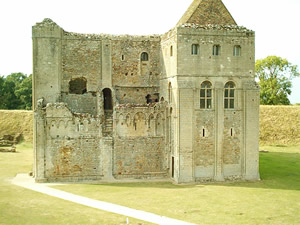
Castle Rising is a twelfth century castle, William d'Albini beginning its construction around 1139. Both the keep and the surrounding earthworks which almost hide it from view are impressive. The keep and part of the gatehouse are all that are left of the castle's buildings, though it once boasted a range of domestic buildings by the keep. The keep itself retains its forebuilding, which for some reason is singled out for decorative arcading reminiscent of that at Norwich (which probably influenced the keep's layout as well). Climbing the stairs up though the forebuilding to the entrance to the hall is quite an impressive experience. Interestingly the remains of the original village church lie within the earthworks, William having built the bank over it. The current church was built in recompense. Castle Rising is noted for being the residence of Queen Isabella, Edward III's mother, after the murder of Edward II.
Norwich Castle
Norwich, Norfolk TG 231 085
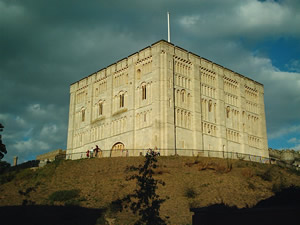
Now a museum, the keep of Norwich Castle is still an imposing figure on the city's skyline. However, it is difficult on close inspection to imagine what this castle was once like. A shopping centre has been built beneath the castle, giving a surreal quality as one emerges from a world of department stores to the medieval bridge across the ditch to the keep. The keep exterior looks fresh, having been resurfaced in the 1830s but old drawings show the work to be a copy of the original, complete with extremely unusual rows of blank arcading. The castle was probably built 1119–32 (they paused in the building of the cathedral then, so…). A thirteenth century curtain wall was added but only the footings of two drum towers remain. The castle fell into disrepair and became used as a court house and prison (the 19th century prison buildings around the keep now house the bulk of the museum). The keep itself was completely gutted. It is now an eerie feeling to stand in the vast space (originally the keep consisted of three floors, complete with chapel and kitchen) and look around. The current cross-wall is a Victorian addition, the original being lost. The forebuilding is also a Victorian restoration.
Scarborough Castle
Scarborough, North Yorkshire TA 049 892
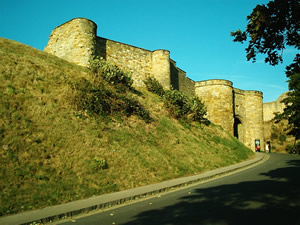
Rising up out of the cliffs overlooking the North Sea, Scarborough is certainly dramatic. So formidable is the site that it has been occupied since the iron age, but it was William le Gros who built a castle there in the 1130s. So powerful was it that when Henry II came to the throne he took Scarborough for his own (it was built on a royal manor). Henry began to rebuild the castle, and his is the keep. Testimony to the strength of the castle is the fact it withstood several sieges. Two during the civil war reduced the castle to ruins and slighted the keep, but the area maintained military occupation for some centuries later. Even the German fleet had a go during the second world war.
The initial castle work consisted mainly of building a curtain wall along the south-west side above the deep ravine separating it from the town. The other two sides of the triangular headland were protected by the steep cliffs. The remains of the wall are still impressive, though the flanking towers are a slightly later addition by King John at the start of the 13th century. He also constructed an outer wall to the inner bailey, extended it down to the cliffs and build a hall in the bailey. The Pipe Rolls show that he spent so much he probably did more as well. Henry
Warwick Castle
Warwick, Warwickshire SP 283 646
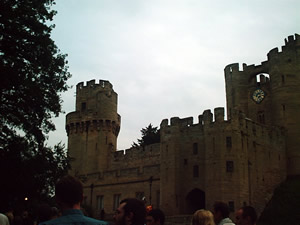
I have had but a brief visit to Warwick castle, actually having dinner there during a summer school for surface science graduate students. I fully intend to return at some point to more completely explore this wonderful castle. Though the castle has become stately home, complete with Capability Brown landscaped gardens, the walls and towers have changed very little. Warwick started life as a typical Norman motte and bailey castle, though little of the Norman work now remains. The castle was severely damaged in 1264 by Simon de Montfort's supporters, so it was in 1331 that Thomas Beauchamp began a reconstruction. The castle passed to his son Thomas, then to Richard Beauchamp before coming into the hands of Richard Neville the "Kingmaker". The first Thomas Beauchamp first reconstructed the domestic buildings along the cliff edge above the River Avon, before embarking on the north-east curtain. This is impressive length, with each tower strangely unique. The central gatehouse comes complete with barbican, in which can still be seen murder holes and two portcullises. There is an obvious french influence to Caesar's and Guy's towers along the wall to the left and right of the gatehouse. The north-west wall is less impressive, falling to meet a rectangular projection guarded by two octagonal towers (a never completed artillery platform).
Resources
Like most things the internet offers many sites dedicated to the castle. Some are better than others. These sites are those I personally like and find the most useful (in not too much of a particular order).
- CastleUK.net has a very good listing of castles, sorted both alphabetically and by region (with a clickable map). Each castle entry has information, photographs, directions and links to relevant web sites (such as the homepage of that castle, English Heritage, etc). Fairly comprehensive. Recommended.
- CastleXplorer has alphabetical listings, and interactive maps to help find castles in England, Scotland and Wales, as well as a brief history of castles. Again each entry comes with photos, directions and links as well as the normal information. Recommended.
- Wikipedia has pages for Castles in England, Castles in Scotland, Castles in Wales and Castles in Northern Ireland. Although not every castle has an individual entry many do, and there are comprehensive lists arranged by county.
- English Heritage own many castles and membership is a must for anyone serious about visiting castles in England (membership gives free entry for the member and any accompanying children to any EH site. Certainly worth the money if you visit a number of such sites). Their sites can be searched by type, including castle, from their website.
- As I live in York some of the easiest castles to get to are those Castles of the Yorkshire Dales.
- Castles of the World has information from a not so British centric point of view, as well as user contributions to castle descriptions and castle related message boards.
- Castles of Wales provides fairly comprehensive information about Welsh castles.
- Data-Wales has information on a few Welsh castles.
- More castles at The Heritage Trail.
- Castles on the Web provides links to further castle related sites and a few other titbits, including discussion forums.
- In May 2003 the UK television Channel 4 ran a serious on castles. The series website is here, with information on the castles looked at.